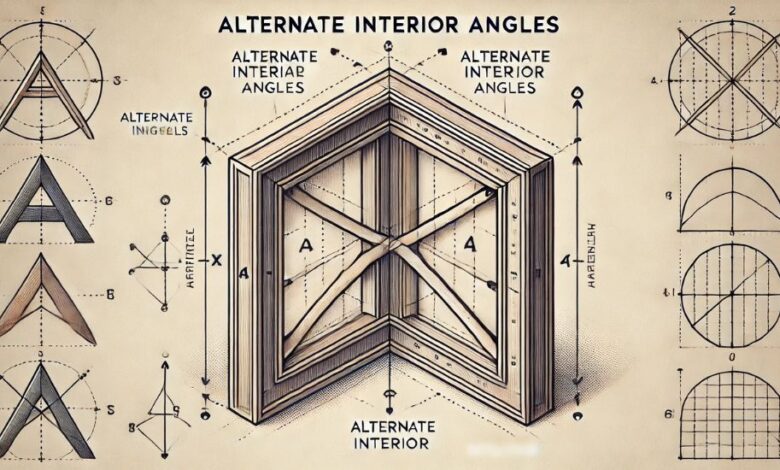Understanding Alternate Interior Angles: A Key Concept in Geometry

In the study of geometry, alternate interior angles hold a vital place, helping us understand the properties of parallel lines and their interactions with transversals. Whether you’re new to geometry or looking for a detailed refresher, this guide explores the essential aspects of alternate interior angles. Here at USA Magzines, we believe that clear explanations of foundational concepts make advanced learning smoother.
What Are Alternate Interior Angles?
Alternate interior angles are pairs of angles found on opposite sides of a transversal line that intersects two parallel lines. They lie within the parallel lines, directly across from one another. An essential property of alternate interior angles is that they are congruent, meaning they have equal measures when the lines intersected by the transversal are parallel. For example, if two parallel lines are intersected by a transversal, the alternate interior angles on either side are equal.
Visual Representation of Alternate Interior Angles
In a typical alternate interior angle scenario, we have:
- Two parallel lines (often labeled as line A and line B)
- A transversal that crosses these lines, creating angles
When the transversal intersects the parallel lines, it forms two distinct sets of alternate interior angles. Each set lies on opposite sides of the transversal but within the boundaries of the parallel lines. In our detailed image for USA Magzines, these angles are highlighted to make understanding easier.
Properties of Alternate Interior Angles
Understanding the properties of alternate interior angles is crucial for solving problems involving parallel lines and transversals. Here are some fundamental properties:
- Congruency: The alternate interior angles are congruent, meaning they are equal in measure. This congruency is a direct result of the parallel nature of the two lines involved.
- Positioning: Alternate interior angles are located on opposite sides of the transversal and between the two parallel lines, thus ‘interior.’
- Supplementary Nature in Non-Parallel Situations: When lines are not parallel, alternate interior angles are not necessarily equal. This inequality helps in determining whether lines are truly parallel.
Alternate Interior Angles Theorem
The alternate interior angles theorem is one of the cornerstone theorems in geometry and states: “If a transversal intersects two parallel lines, then each pair of alternate interior angles is congruent.” This theorem is a powerful tool for proving that two lines are parallel. If we know the alternate interior angles are congruent, we can conclude that the lines are parallel.
In real-world applications and academic settings, this theorem assists in various proofs and constructions, making it an invaluable tool in geometry.
Applications of Alternate Interior Angles in Real Life
Though alternate interior angles seem purely theoretical, they have several practical applications:
- Architecture and Engineering: When designing parallel structures or assessing angles, alternate interior angles help verify that lines and structures maintain their intended alignments.
- Computer Graphics: In graphics software, alternate interior angles ensure parallelism in digital design, especially in 3D modeling and geometric constructions.
- Navigation and Mapping: Maps and blueprints often use the principles of alternate interior angles to ensure accuracy in plotting parallel paths.
How to Identify Alternate Interior Angles
Recognizing alternate interior angles is straightforward:
- Identify the Parallel Lines: Start by locating the two parallel lines in the diagram.
- Find the Transversal: Look for the line that crosses both parallel lines.
- Locate the Interior Angles: The angles inside the parallel lines on either side of the transversal are the alternate interior angles.
In our image provided for this article on USA Magzines, these steps are clearly visualized, offering a straightforward way to spot alternate interior angles.
Using Alternate Interior Angles in Proofs
Alternate interior angles are frequently used in geometric proofs. When you encounter a problem involving parallel lines and a transversal, identifying the alternate interior angles and applying their properties can often lead to the solution. Here’s a typical setup for using alternate interior angles in a proof:
- State Given Information: Start with the given information, often involving two parallel lines intersected by a transversal.
- Identify Congruent Alternate Interior Angles: Use the alternate interior angles theorem to establish congruence.
- Use Congruence to Conclude: Often, the congruence of alternate interior angles allows for conclusions about the angles or sides of figures in the problem.
This method is essential in many geometry problems, from simple angle identification to complex constructions.
Common Misconceptions About Alternate Interior Angles
Several misconceptions about alternate interior angles arise due to confusion with other types of angles:
- Confusing with Corresponding Angles: Corresponding angles lie on the same side of the transversal but in different positions (one interior and one exterior), unlike alternate interior angles.
- Assuming Congruency Without Parallel Lines: Alternate interior angles are congruent only when the lines are parallel. Without this condition, the angles may vary in size.
At USA Magzines, we aim to clarify such misconceptions, allowing students and enthusiasts to approach geometry confidently.
Alternate Interior Angles in Parallel Line Proofs
Alternate interior angles are pivotal in proofs concerning parallel lines. Suppose you have two lines intersected by a transversal, and the alternate interior angles are congruent. This congruency can be used to conclude that the lines are indeed parallel. This application is especially useful when working in reverse: proving parallelism based on angle congruency rather than assuming it initially.




